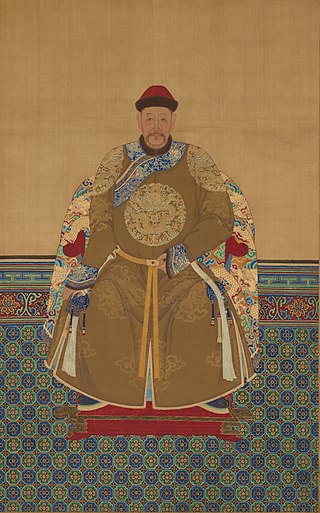This article needs additional citations for verification .(September 2020) |
Joogiya (兆佳) was a clan of Manchu nobility.
This article needs additional citations for verification .(September 2020) |
Joogiya (兆佳) was a clan of Manchu nobility.
Imperial Consort
Princess Consort

The Daoguang Emperor, also known by his temple name Emperor Xuanzong of Qing, personal name Mianning, was the seventh emperor of the Qing dynasty, and the sixth Qing emperor to rule over China proper, reigning from 1820 to 1850. His reign was marked by "external disaster and internal rebellion." These included the First Opium War and the beginning of the Taiping Rebellion which nearly brought down the dynasty. The historian Jonathan Spence characterizes the Daoguang Emperor as a "well meaning but ineffective man" who promoted officials who "presented a purist view even if they had nothing to say about the domestic and foreign problems surrounding the dynasty."

The Niohuru were a prominent Manchu clan during the Qing dynasty. The clan had inhabited the Changbai Mountains since as early as the Liao dynasty. The clan was well known during the Qing dynasty for producing a variety of consorts of all ranks for emperors, several of whom went on to become mothers to reigning emperors. Prominent people who belonged or trace heritage to the Niohuru clan including famed Manchu warrior Eidu, his son the high official Ebilun, the Empress Dowager Ci'an, the infamous corrupt official Heshen, the contemporary concert pianist Lang Lang and Lang Tsuyun, Taiwanese TV, movie and stage actress, singer and producer.

Yinxiang, formally known as Prince Yi, was a Manchu prince of the Qing dynasty. The thirteenth son of the Kangxi Emperor, Yinxiang was a major ally of his brother Yinzhen during the latter's struggle for the succession of the throne. He was made a qinwang during Yongzheng's reign and became one of his closest advisors. He died eight years into the reign of the Yongzheng Emperor and was memorialized with top honours by the emperor. When he died, his title was granted "iron-cap" status and became perpetually inheritable, one of the only twelve such princes in Qing dynasty history.
Gūwalgiya was one of the most powerful Manchu clans. It is often listed by historians as the first of the eight prominent Manchu clans of the Qing dynasty. After the demise of the dynasty, some of its descendants sinicized their clan name to the Han Chinese surname Guan (關).
Tunggiya is the name of a Manchu clan.
Ajige was a Manchu prince and military general of the early Qing dynasty. He was born in the Aisin Gioro clan as the 12th son of Nurhaci, the khan of the Later Jin dynasty.

Empress Xiaozhaoren, of the Manchu Bordered Yellow Banner Niohuru clan, was a posthumous name bestowed to the wife and second empress consort of Xuanye, the Kangxi Emperor. She was empress consort of China during the Qing dynasty from 1677 until her death in 1678.

Consort Shu, of the Manchu Plain Yellow Banner Yehe Nara clan, was a consort of the Qianlong Emperor. She was 17 years younger than him.

Nara is a clan name shared by a number of royal Manchu clans, sometimes also transliterated as Nalan or Nalland. The four tribes of the Hūlun confederation (扈倫四部) – Hada, Ula, Hoifa and Yehe – were all ruled by clans bearing this name.

Daišan was an influential Manchu prince and statesman of the Qing dynasty.
Yinzhi, also known as Yunzhi, formally known as Prince Zhi of the Second Rank between 1698 and 1708, was a Manchu prince of the Qing dynasty.
Uya was a clan of Manchu nobility.
Fuca was a clan of Manchu nobility. After the demise of the dynasty, some of its descendants sinicized their clan name to the Chinese surnames Fu (富/傅) or Li (李).
Noble Consort Wenxi, of the Manchu Bordered Yellow Banner Niohuru clan, was a consort of the Kangxi Emperor.
Daoguang Emperor had fifteen consorts, including four empresses, one imperial noble consort, three noble consorts, three consorts and four concubines.
Sirin Gioro was a clan of the Manchu nobility, one of the prominent Gioro family. The other clans of Gioro Hala were Aisin Gioro (爱新觉罗), the ruling clan from 1616 to 1912, Irgen Gioro (伊尔根觉罗) and Šušu Gioro (舒舒觉罗). The clan belonged to the Bordered Blue Banner. The clan members inhabited the area ranging from Nimaca, Hoifa, Changbai Mountains, Jianzhou, Ningguta and Hada
Gorolo (郭络罗氏) was a clan of Manchu nobility belonging to Bordered Yellow Banner
Lady Yehenara was primary consort of Zaize, 5th generation descendant of Yunxu, Prince Yuke of the Second Rank and Kangxi Emperor's 15th surviving son. She was two years older than him. Her personal name was Jingrong.
Consort Rong of the Manchu Plain Yellow Banner Magiya clan, was a imperial consort of the Kangxi Emperor.
Namjung of the Abaga Borjigit clan, formally known as Noble Consort Yijing (懿靖貴妃), was the wife of Ligdan Khan, who after his death became a concubine of Hong Taiji.